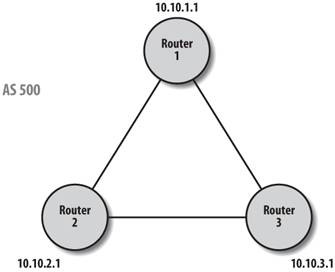Peer Groups
When working with BGP, you will find that many routers require the same neighbor statements in their configurations. No matter what kind of routing policy you're implementing and how you're implementing it, if you want the same policy lists applied to a group of neighbors, you'll end up giving the same parameters on all the neighbor statements. This process can be error-prone and confusing.
Peer groups eliminate redundant configuration lines by allowing you to define a group and then make each neighbor a part of that group. For example, assume that you have a route map that enforces some routing policy. Instead of applying that route map separately on each neighbor, you can add all the neighbors to a peer group and then apply the route map for the group as a whole.
In Figure 10-3, we have a network (AS 500) with three BGP routers. Instead of defining the same route maps for each neighbor in Router 1's configuration, we create a peer group called policy1. This peer group defines the non-unique configuration items. We then make Router 2 and Router 3 members of this peer group. Here is the BGP configuration for Router 1:
Figure 10-3. iBGP network with peer-group configuration

router bgp 500 ! Define our peer group and apply the configuration items to it neighbor policy1 peer-group neighbor policy1 remote-as 500 neighbor policy1 next-hop-self neighbor policy1 route-map map1 in ! Now define our neighbors as part of peer group policy1 neighbor 10.10.2.1 peer-group policy1 neighbor 10.10.3.1 peer-group policy1
We can use the same peer-group configuration on Router 2 and Router 3. Unfortunately, we'll still have to type almost identical configurations on each router, but at least we've reduced the amount of duplication on the individual routers. We still have to keep our router configurations in sync, but the peer-group concept makes it easier to keep the configuration uniform within a router.
Getting Started
- Getting Started
- IOS User Modes
- Command-Line Completion
- Get to Know the Question Mark
- Command-Line Editing Keys
- Pausing Output
- show Commands
IOS Images and Configuration Files
- IOS Images and Configuration Files
- IOS Image Filenames
- The New Cisco IOS Packaging Model
- Loading Image Files Through the Network
- Using the IOS Filesystem for Images
- The Routers Configuration
- Loading Configuration Files
Basic Router Configuration
- Basic Router Configuration
- Setting the Router Name
- Setting the System Prompt
- Configuration Comments
- The Enable Password
- Mapping Hostnames to IP Addresses
- Setting the Routers Time
- Enabling SNMP
- Cisco Discovery Protocol
- System Banners
Line Commands
- Line Commands
- The line Command
- The Console Port
- Virtual Terminals (VTYs)
- Asynchronous Ports (TTYs)
- The Auxiliary (AUX) Port
- show line
- Reverse Telnet
- Common Configuration Items
Interface Commands
- Interface Commands
- Naming and Numbering Interfaces
- Basic Interface Configuration Commands
- The Loopback Interface
- The Null Interface
- Ethernet, Fast Ethernet, and Gigabit Ethernet Interfaces
- Token Ring Interfaces
- ISDN Interfaces
- Serial Interfaces
- Asynchronous Interfaces
- Interface show Commands
Networking Technologies
Access Lists
IP Routing Topics
- IP Routing Topics
- Autonomous System (AS) Numbers
- Interior and Exterior Gateway Protocols
- Distance-Vector and Link-State Routing Protocols
- Static Routes
- Split Horizon
- Passive Interfaces
- Fast Switching and Process Switching
Interior Routing Protocols
Border Gateway Protocol
- Border Gateway Protocol
- Introduction to BGP
- A Simple BGP Configuration
- Route Filtering
- An Advanced BGP Configuration
- Neighbor Authentication
- Peer Groups
- Route Reflectors
- BGP Confederacies
- BGP TTL Security
Quality of Service
- Quality of Service
- Marking
- Older Queuing Methods
- Modern IOS QoS Tools
- Congestion Avoidance
- Traffic Policing
- Traffic Shaping
- AutoQoS
- QoS Device Manager
Dial-on-Demand Routing
- Dial-on-Demand Routing
- Configuring a Simple DDR Connection
- Sample Legacy DDR Configurations
- Dialer Interfaces (Dialer Profiles)
- Multilink PPP
- Snapshot DDR
Specialized Networking Topics
- Specialized Networking Topics
- Bridging
- Hot Standby Routing Protocol (HSRP)
- Network Address Translation (NAT)
- Tunnels
- Encrypted Tunnels
- Multicast Routing
- Multiprotocol Label Switching (MPLS)
Switches and VLANs
- Switches and VLANs
- Switch Terminology
- IOS on Switches
- Basic Switch Configuration
- Trunking
- Switch Monitor Port for IDS or Sniffers
- Troubleshooting Switches
Router Security
- Router Security
- Securing Enable Mode Access
- Routine Security Measures
- Restricting Access to Your Router
Troubleshooting and Logging
Quick Reference
Appendix A Network Basics
Index
EAN: 2147483647
Pages: 1031
